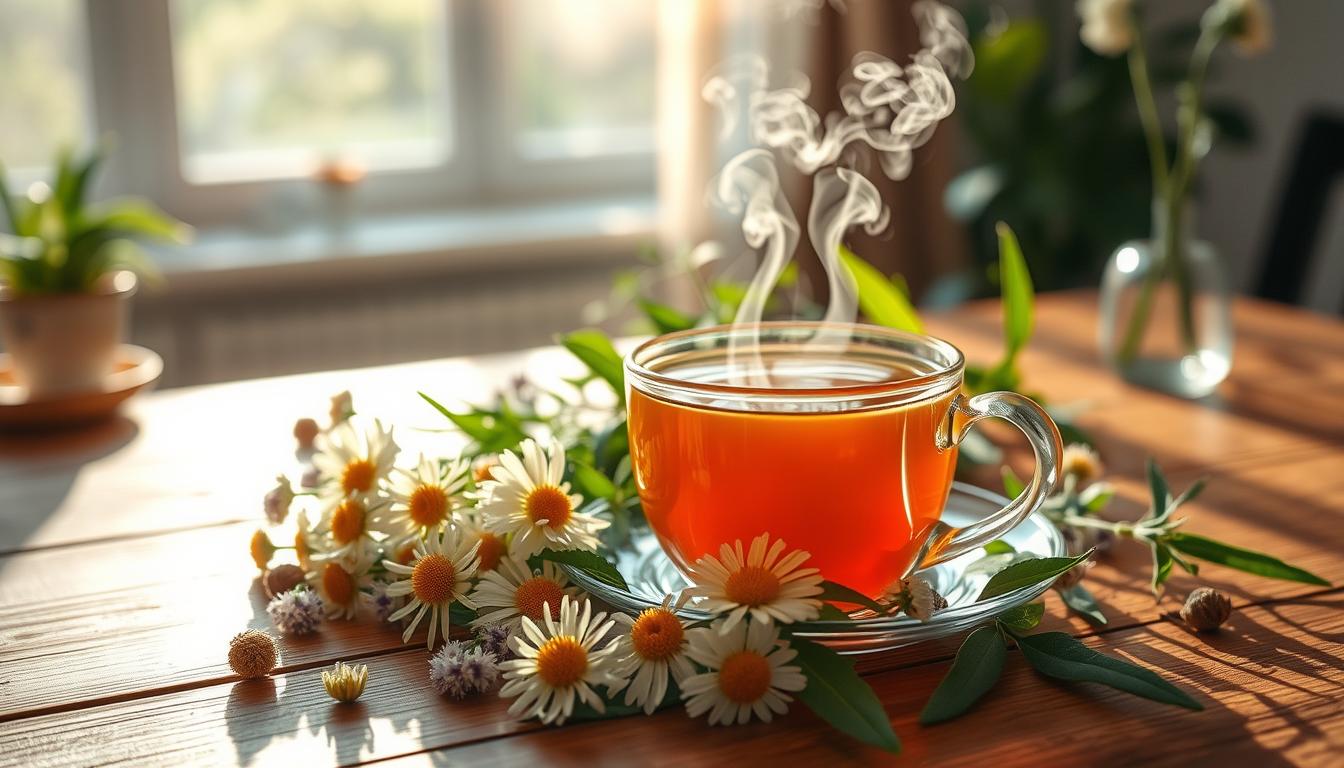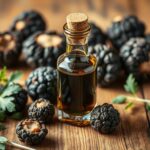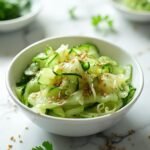Did you know arnica montana showed a 93% efficacy in reducing inflammation? This was found in a 2004 animal study by Macedo S.B. and the team. This impressive stat shows how powerful arnica tea can be. It’s well-known for easing pain and fighting inflammation. But, arnica tea also has many other health benefits, making it a top choice among herbal remedies.
- Introduction to Arnica Tea
- Origins and Traditional Uses of Arnica
- Active Ingredients in Arnica Tea
- Health Benefits of Arnica Tea
- What Is Arnica Tea Good For?
- Topical Applications of Arnica Tea
- Safety and Side Effects of Arnica Tea
- How to Prepare Arnica Tea for Topical Use
- Precautions and Contraindications
- Conclusion
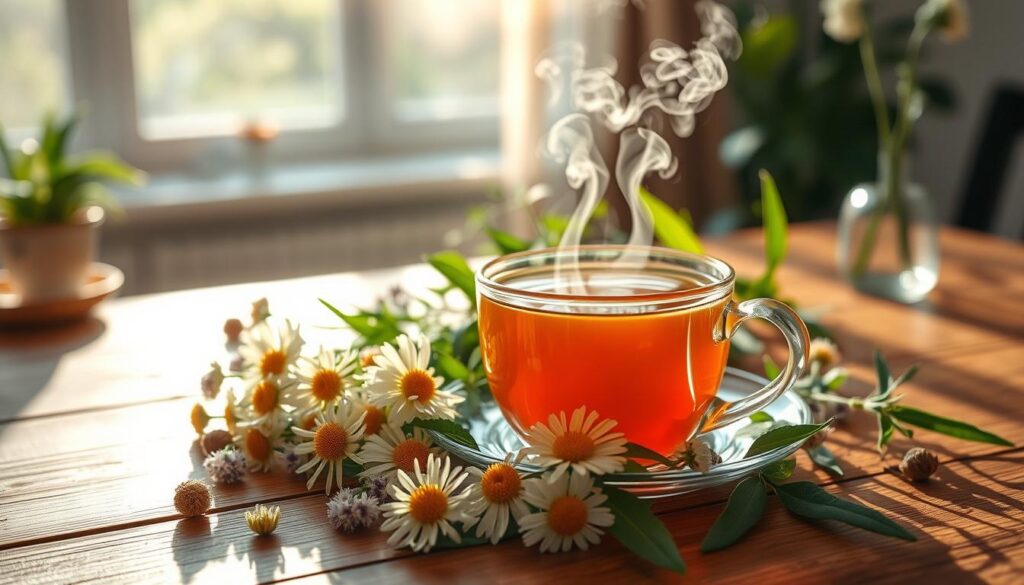
Arnica tea comes from the dried flowers of the Arnica Montana plant. It’s been used in natural healing with arnica for a long time. It helps with muscle soreness, cuts down on inflammation, and helps wounds heal faster. This anti-inflammatory tea is chosen by many seeking holistic well-being. However, because it has helenalin, too much can be harmful. This is why talking to a healthcare expert before using arnica tea is essential. Let’s explore more about what arnica tea does and all its benefits.
Introduction to Arnica Tea
Arnica tea isn’t as famous as other herbal teas, but it’s known for pain relief. It comes from Arnica montana, also called Mountain tobacco or Leopard’s bane. This plant has a long history in European traditional medicine and homeopathic remedies.
Arnica has 150 bio-active ingredients. A 2007 study showed it’s as good as topical NSAIDs for hand osteoarthritis. Homeopathic arnica remedies, though, don’t have proven safety or effectiveness.
Arnica supplements and teas are poisonous if consumed. The FDA has warned about the dangers of injectable arnica. Eating or drinking arnica can hurt your organs, or worse. That’s why Canada doesn’t allow arnica in food.
Arnica herbal tea shows the fine line between benefit and safety in herbal treatments. Arnica tea, mainly used on the skin, can be toxic if swallowed. This caution reminds us to understand both the good and bad before trying homeopathic remedies.
| Comparative Effectiveness | Arnica | Topical NSAIDs |
|---|---|---|
| Pain Relief | Effective | Effective |
| Safety | High Risk if Ingested | Low Risk |
| Application | Topical | Topical |
Origins and Traditional Uses of Arnica
Exploring arnica origins unveils a deep history in European herbal remedies. The plant, particularly Arnica montana, has been key in traditional herbal medicine for a long time. Originating in Europe’s temperate areas, it spread to North America, where it became fundamental to healing practices.
Arnica has been praised for its use on the outside of the body for many years. It has helped ease pains and bruises for centuries. Scientific research backs its benefits in these areas. For example, a study by Kriplani, Guarve, and Baghael in 2017 shows Arnica montana has healing powers. Another review in 2013 supported its role in easing pain after surgery.
Arnica’s journey to other lands led to its use in American traditional herbal medicine. But, it must be used with care.
Research in 2006 found homeopathic arnica helped knee surgery patients. Yet, it stressed the need for safe amounts to avoid the risk of harm from taking it internally.
Historical uses of arnica highlight its value in treating injuries, showing its strong presence in both modern and old healing methods. Clinical trials by Kaziro in 1984 and others prove arnica’s ability to manage pain and heal bruises. This confirms its long-time use in European herbal remedies.
Active Ingredients in Arnica Tea
Arnica tea is known for its special mix of active parts. These parts are key to its health benefits. They are especially good for treating inflammation and stress from oxidation.
Anti-inflammatory Compounds
The main ingredients that fight inflammation in arnica tea are called sesquiterpene lactones, like helenalin. These compounds control the production of substances that cause inflammation and pain. Thus, they reduce these symptoms. Helenalin specifically helps by aiming at the pathways that cause inflammation. This provides relief and aids the body’s healing.
Antioxidant Properties
Arnica tea also has strong antioxidant effects. These are vital for healing in the body. The antioxidants come from flavonoids and essential oils in the tea. They help prevent damage from free radicals. This supports the health of our cells and their ability to bounce back.
Studies show that how arnica is sourced and prepared affects its healing powers. The age of the flowers and how they are gathered matter a lot. They make sure the tea’s active parts are as effective as possible, giving users the greatest benefits.
Health Benefits of Arnica Tea

Arnica tea is famous for its healing powers in homeopathy. It brings major health benefits like boosting wound healing. Active compounds like flavonoids make it effective against various health issues.
Arnica combines anti-inflammatory health benefits and natural pain relief. It’s useful for bruises and joint pain. A 2007 study showed that arnica gel can match ibuprofen in easing hand osteoarthritis pain. This proved arnica’s potential for reducing pain and inflammation.
A study on knee arthritis patients showed arnica gel lessened pain and stiffness with twice-daily use for three to six weeks. Post-surgery patients also felt better in two weeks, proving arnica’s effectiveness.
Health benefits of arnica tea also include better recovery after physical exertion. A study found that topical arnica lessened muscle soreness post-workout. This highlights its natural pain relief quality.
| Study | Findings |
|---|---|
| 2007 Osteoarthritis Study | Arnica gel provided similar pain relief as ibuprofen with minimal side effects. |
| Knee Arthritis Study | Significant reduction in pain and stiffness with twice daily use. |
| Post-Surgery Pain Study | Patients experienced notable pain relief within two weeks compared to placebo. |
| Exercise Recovery Study | Reduced muscle soreness and pain 72 hours post-intense exercise. |
Arnica flowers’ oil, rich in natural anti-inflammatory health, helps with swelling. It soothes sports injuries and fights aging. The antioxidants it contains may also aid skin conditions like eczema.
The health benefits of arnica tea are clear. It’s an asset to natural health practices. However, more research is needed on its safety when drunk.
What Is Arnica Tea Good For?
Arnica tea is praised as a natural remedy with many health benefits. It is known for offering relief from soreness and muscle pain. This tea is great for easing pain and inflammation. It helps people recovering from muscle strains, osteoarthritis, and surgeries.
Research shows arnica gel is as good as ibuprofen for pain but has fewer side effects. One study with 204 people showed it’s effective for hand osteoarthritis pain. Another study found it reduced knee arthritis pain and stiffness over three to six weeks.
Arnica tea applications are not just for pain. It helps post-surgery patients feel less pain within two weeks. A study between 1998 and 2002 supported this. For athletes, it reduces soreness and speeds up recovery. The “European Journal of Sport and Science” found topical arnica helped reduce muscle pain after exercise.
Arnica also boosts holistic health. It promotes hair growth by nourishing the scalp. The oil’s anti-inflammatory quality reduces swelling from injuries. It can also help with skin issues like eczema, psoriasis, and rosacea. This is thanks to its antioxidants.
Since the 1500s, arnica has been valued for its healing effects. It’s key in alternative medicine. It helps with surgical recovery, reducing pain and swelling. Plus, it offers antibacterial and antiviral benefits to strengthen the immune system. Arnica tea applications reveal its wide potential for health and wellness.
Topical Applications of Arnica Tea
Arnica tea is known for its health benefits, especially when used on the skin. It contains substances like flavonoid glycosides and terpenoids, which reduce inflammation and pain.
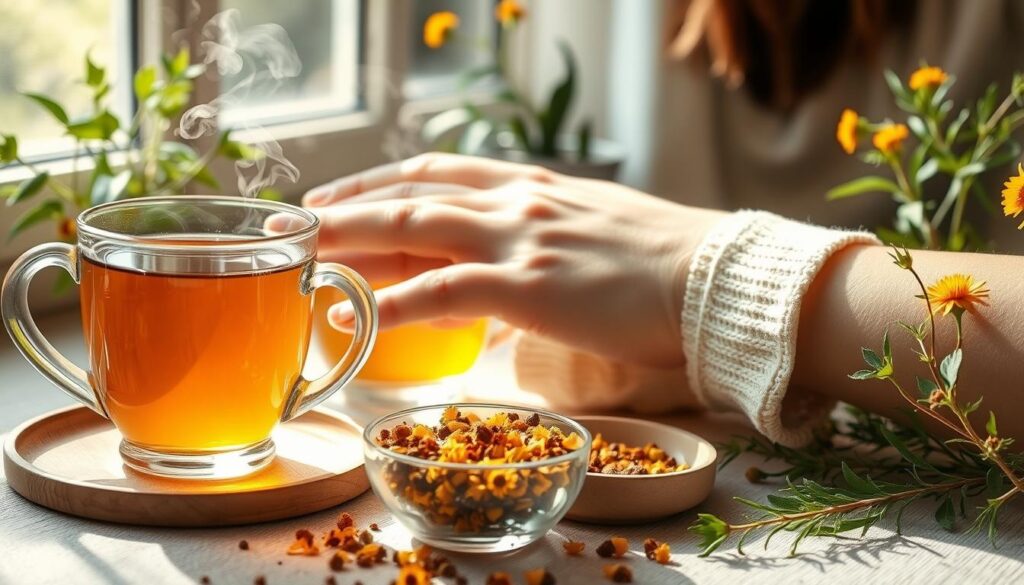
Treatment of Bruises and Muscle Soreness
Applying arnica tea to the skin helps with bruises and muscle soreness. It lessens bruising and inflammation, aiding the body’s healing. This is due to its active parts like lactones.
- Helps to reduce local inflammation
- Supports the body’s healing processes
- Minimizes the appearance of physical trauma
Arnica is also great for muscle soreness. Putting arnica tea compresses on sore areas can lessen discomfort. This helps muscles recover faster from strain or injuries.
Joint Pain Relief
Arnica tea aids in relieving joint pain naturally. People with osteoarthritis find that it improves movement and lessens stiffness and pain. Active compounds in arnica reduce joint discomfort, helping improve life quality.
| Condition | Benefits of Arnica Tea |
|---|---|
| Bruises | Reduces the appearance and promotes healing |
| Muscle Soreness | Alleviates pain and expedites recovery |
| Joint Pain | Improves mobility and decreases stiffness |
Knowing these therapeutic properties shows arnica tea’s value. It’s a natural option for bruises, muscle soreness, and joint pain management.
Safety and Side Effects of Arnica Tea
Arnica is well-liked for its healing effects. But, it’s important to understand arnica tea safety and potential side effects. Everyone should follow certain safety tips.
Taking arnica by mouth without diluting it can be harmful. Published studies have pointed out risks like stomach problems, high blood pressure, and brain issues. For example, a 2010 study in the British Journal of Clinical Pharmacology showed that Arnica montana and Bryonia alba had no positive effect on surgery recovery. This tells us to be careful with how much and how we use it.
It’s crucial to know the difference between using arnica on your skin and eating it. A 2002 study showed arnica helps with pain after a specific surgery when used on the skin. However, if you’re allergic to certain plants, arnica could cause a skin reaction.
A deeper look at arnica’s effects in different uses points out important facts:
| Application | Study | Outcome |
|---|---|---|
| Post-surgery (Arnica ointment) | Plastic and Reconstructive Surgery, 2016 | No improvement in upper blepharoplasty outcomes |
| Osteoarthritis of the knee (Topical Arnica gel) | Advances in Therapy, 2002 | Showed it works in a big trial |
| Hand osteoarthritis (Comparison with NSAIDs) | Rheumatology International, 2007 | Works as well as NSAIDs but with fewer side effects |
It’s essential to stick to arnica precautions. Always use it as advised. Never take arnica inside your body without a doctor’s guidance to stay safe.
Being aware of potential side effects and following safety tips ensures arnica helps without causing harm.
How to Prepare Arnica Tea for Topical Use
Preparing arnica tea right is key to getting the most out of it. We’ll show you how to make arnica tea for treating bruises, contusions, and skin injuries.
- Compress Method: Brew a strong arnica tea by steeping dried flowers in boiling water for 10–15 minutes. Let the tea cool to lukewarm. Then, dip a clean cloth in it, squeeze out extra tea, and place it on the hurt area.
- Ointment and Oil Preparation: Mix the arnica tea with a carrier oil like coconut or olive. This homemade arnica cure helps soothe bruises and aching muscles. It works because of arnica’s anti-inflammatory stuff.
- Gargling Solution: For a sore throat or toothache, gargle with cooled, diluted arnica tea. Be sure not to swallow it as drinking arnica tea isn’t safe without a doctor’s okay.
It’s crucial not to put arnica on open cuts to avoid dangerous stuff getting into your skin. These homemade arnica cures need careful use. Too much arnica might dry out the skin or raise blood pressure.
Always talk to a doctor before trying new remedies, like topical arnica applications. The right way of preparing arnica tea lets you harness its healing power safely.
| Preparation Method | Details |
|---|---|
| Compress | Steep arnica flowers for 10-15 minutes, cool, soak cloth, and apply. |
| Ointment/Oil | Mix arnica tea with carrier oil, use on sore spots. |
| Gargling Solution | Use cooled, diluted tea for gargling. Don’t swallow. |
Trying out various arnica tea recipes for outside use can show many ways to gain from this herb. This ensures you stay safe and get good results.
Precautions and Contraindications
Before using arnica for health, know the arnica contraindications and precautions with arnica. This herb comes in tablets, ointments, and gels. Yet, its side effects and interactions with some conditions and medicines call for caution.
Precautions for Pregnant Women
Pregnant and nursing women need to steer clear of arnica. The absence of solid safety data makes it risky. Pure arnica’s dangerous, possibly leading to health issues in such sensitive times. Safer options should be considered, and a doctor’s advice sought first.
Allergic Reactions
Knowing the signs of an arnica allergy is key, especially for those already allergic to certain plants. Applying homeopathic arnica might result in skin problems like irritation. Although applying diluted arnica on unbroken skin might be okay, eating it in high doses is unsafe and can cause serious harm. Always test a small area of your skin first and talk to a healthcare professional if you have allergy concerns.
| Potential Issues | Details |
|---|---|
| Pregnant Women | Strongly advised to avoid arnica, due to lack of safety data and potential toxicity. |
| Children | Generally not recommended for use in this demographic to prevent potential risks. |
| Specific Allergies | Risk of allergic reactions particularly in those allergic to the Asteraceae/Compositae family. |
| Topical Reactions | Potential skin irritation and burning when used in the form of homeopathic creams or gels. |
| Oral Intoxication | Potentially severe side effects, including increased bleeding, organ failure, and death when ingested in large, undiluted forms. |
Conclusion
Our exploration shows arnica tea as a herb with deep roots and promising benefits. It has a long history in natural medicine. Today, it’s used for muscle soreness and recovery after surgery. Its effects are noted in history and science, though outcomes can vary.
Arnica contains compounds that fight inflammation and boost health. Reviews and trials show it can help with things like sore muscles and surgery recovery. But, it’s important to use it safely. Eating or drinking it can be risky, so skin applications are safer.
In short, arnica tea can be great for natural pain relief and healing when used right. This summary shows its value in homeopathic care. Always follow safety tips to enjoy its full benefits safely. This end note stresses the need to use arnica wisely, as it is a strong, helpful herb for health problems.


